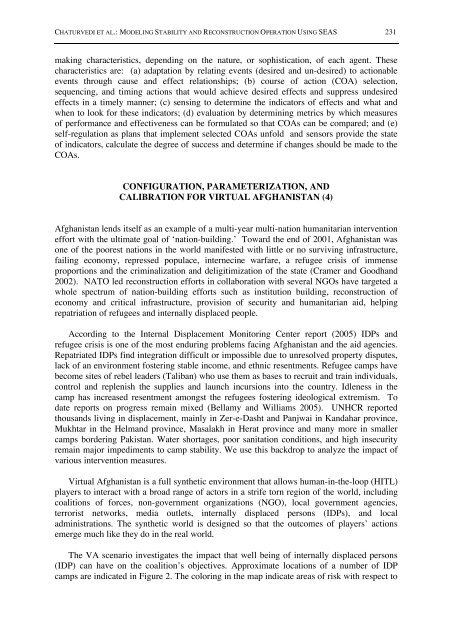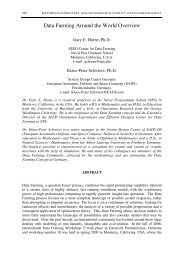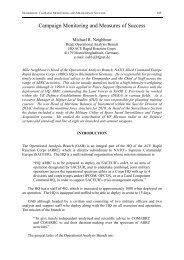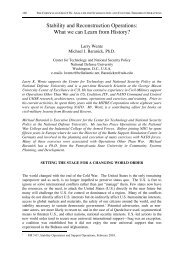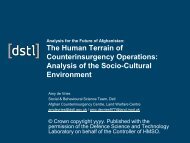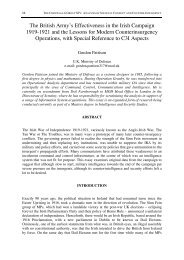Modeling Stability and Reconstruction Operation ... - Cornwallis Group
Modeling Stability and Reconstruction Operation ... - Cornwallis Group
Modeling Stability and Reconstruction Operation ... - Cornwallis Group
You also want an ePaper? Increase the reach of your titles
YUMPU automatically turns print PDFs into web optimized ePapers that Google loves.
CHATURVEDI ET AL.: MODELING STABILITY AND RECONSTRUCTION OPERATION USING SEAS 231making characteristics, depending on the nature, or sophistication, of each agent. Thesecharacteristics are: (a) adaptation by relating events (desired <strong>and</strong> un-desired) to actionableevents through cause <strong>and</strong> effect relationships; (b) course of action (COA) selection,sequencing, <strong>and</strong> timing actions that would achieve desired effects <strong>and</strong> suppress undesiredeffects in a timely manner; (c) sensing to determine the indicators of effects <strong>and</strong> what <strong>and</strong>when to look for these indicators; (d) evaluation by determining metrics by which measuresof performance <strong>and</strong> effectiveness can be formulated so that COAs can be compared; <strong>and</strong> (e)self-regulation as plans that implement selected COAs unfold <strong>and</strong> sensors provide the stateof indicators, calculate the degree of success <strong>and</strong> determine if changes should be made to theCOAs.CONFIGURATION, PARAMETERIZATION, ANDCALIBRATION FOR VIRTUAL AFGHANISTAN (4)Afghanistan lends itself as an example of a multi-year multi-nation humanitarian interventioneffort with the ultimate goal of ‘nation-building.’ Toward the end of 2001, Afghanistan wasone of the poorest nations in the world manifested with little or no surviving infrastructure,failing economy, repressed populace, internecine warfare, a refugee crisis of immenseproportions <strong>and</strong> the criminalization <strong>and</strong> deligitimization of the state (Cramer <strong>and</strong> Goodh<strong>and</strong>2002). NATO led reconstruction efforts in collaboration with several NGOs have targeted awhole spectrum of nation-building efforts such as institution building, reconstruction ofeconomy <strong>and</strong> critical infrastructure, provision of security <strong>and</strong> humanitarian aid, helpingrepatriation of refugees <strong>and</strong> internally displaced people.According to the Internal Displacement Monitoring Center report (2005) IDPs <strong>and</strong>refugee crisis is one of the most enduring problems facing Afghanistan <strong>and</strong> the aid agencies.Repatriated IDPs find integration difficult or impossible due to unresolved property disputes,lack of an environment fostering stable income, <strong>and</strong> ethnic resentments. Refugee camps havebecome sites of rebel leaders (Taliban) who use them as bases to recruit <strong>and</strong> train individuals,control <strong>and</strong> replenish the supplies <strong>and</strong> launch incursions into the country. Idleness in thecamp has increased resentment amongst the refugees fostering ideological extremism. Todate reports on progress remain mixed (Bellamy <strong>and</strong> Williams 2005). UNHCR reportedthous<strong>and</strong>s living in displacement, mainly in Zer-e-Dasht <strong>and</strong> Panjwai in K<strong>and</strong>ahar province,Mukhtar in the Helm<strong>and</strong> province, Masalakh in Herat province <strong>and</strong> many more in smallercamps bordering Pakistan. Water shortages, poor sanitation conditions, <strong>and</strong> high insecurityremain major impediments to camp stability. We use this backdrop to analyze the impact ofvarious intervention measures.Virtual Afghanistan is a full synthetic environment that allows human-in-the-loop (HITL)players to interact with a broad range of actors in a strife torn region of the world, includingcoalitions of forces, non-government organizations (NGO), local government agencies,terrorist networks, media outlets, internally displaced persons (IDPs), <strong>and</strong> localadministrations. The synthetic world is designed so that the outcomes of players’ actionsemerge much like they do in the real world.The VA scenario investigates the impact that well being of internally displaced persons(IDP) can have on the coalition’s objectives. Approximate locations of a number of IDPcamps are indicated in Figure 2. The coloring in the map indicate areas of risk with respect to


